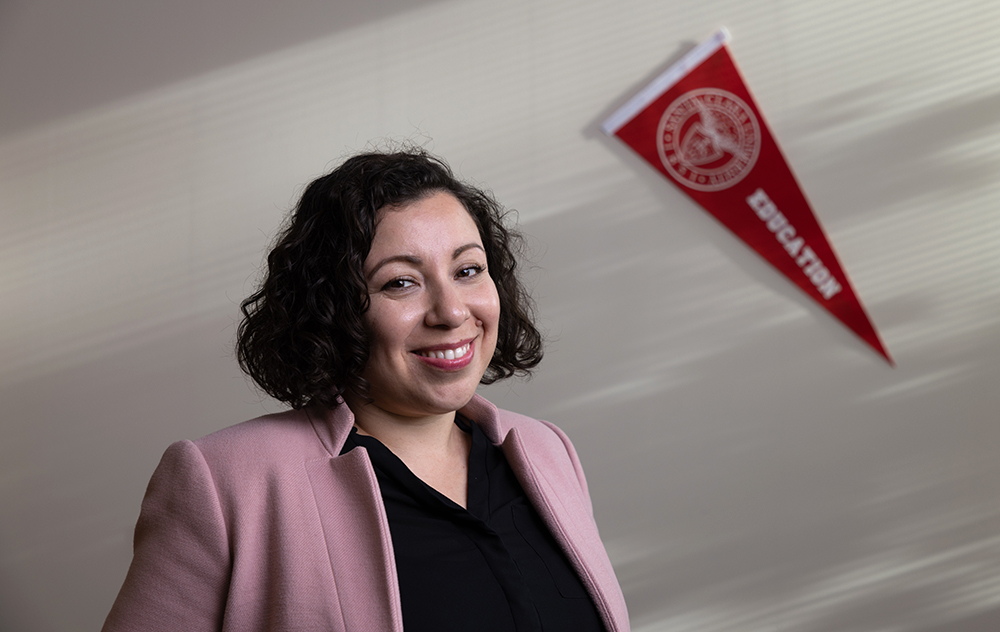
Breaking Barriers in Bilingual Education
A $2.6 million grant from the United States Department of Education will help three faculty members from the School of Education and Counseling Psychology develop and curate new resources for bilingual K-8 educators.
Claudia Rodriguez-Mojica was 5 years old when her language skills were first identified as a problem in school.
When she enrolled in Kindergarten at Hamilton Elementary School, she was given a state-mandated test to assess her English speaking and listening skills. Rodriguez-Mojica, who only spoke Spanish at home with her family, was asked to perform basic English language tasks—“copy the letter B here,” or “point to the word that needs an uppercase or capital letter.”
She didn’t pass.
This test changed the trajectory of her academic career for the next few years. Rodriguez-Mojica was regularly pulled from class to receive English development instruction. Teachers tested her language proficiency each school year until she advanced out of the ELL program in 3rd or 4th grade.
But even as her English improved, she saw her parents struggle to understand and communicate with some of her teachers. The language barrier at times seemed insurmountable.
Today, Rodriguez-Mojica is an associate professor and bilingual authorization coordinator for Santa Clara’s Department of Education determined to change the way bilingual education is approached in schools.
Her newest project, which recently received a $2.6 million grant from the U.S. Department of Education, aims to celebrate and leverage students’ Spanish skills in the classroom, while also bridging language and cultural barriers between home and school. It’s the experience she wished she had as a child.
“There can be a big barrier between bilingual students, teachers and parents,” says Rodriguez-Mojica. “Bilingual or dual language schooling helps bridge that barrier. Because when your kid is in a dual language school, the teachers speak Spanish and English, so parents are able to approach them, talk with them, in Spanish. That’s huge. They’re able to make connections and not have to wait until there’s a translator available.”
Over the next five years, Rodriguez-Mojica and several colleagues will expand resources for English learners and their families. Rodriguez-Mojica, Karla Lomelí, and Kathy Stoehr of SCU’s School of Education and Counseling Psychology will support K-8 educators teaching in Spanish-English, dual immersion programs across California and New Mexico. The trio will curate online workshops in Spanish focused on helping teachers develop culturally-competent, inclusive learning that celebrates students’ language skills.
“This is huge, because although these educators are teaching in Spanish and English, a lot of the professional development available to them is only in English,” says Rodriguez-Mojica. “We’re excited to be able to offer these workshops in Spanish and online. That will allow us to work with bilingual teachers beyond the teachers who are driving distance from Santa Clara.”
The workshops will focus on three strands: biliteracy, or how to teach students to read and write in English and Spanish; culturally and linguistically responsive practices that help teachers learn about and connect with families on a personal level; and strategies that support English learners in accessing content such as math, science, and social studies.
Allison Briceño from San Jose State University will also join the effort, helping develop online Spanish content for teachers focused on strengthening students’ vocabulary, comprehension, and writing. Those resources—which will include videos and curriculum guides—are expected to launch on the digital platform, Canvas in 2023, and will remain available to teachers and caregivers in perpetuity, at no cost—even after the grant period ends in 2026.
Inclusivity in learning
California and New Mexico have some of the highest numbers of K-8 English Language Learners in the U.S., according to the National Center for Education Statistics. More than 19% of California’s public school students were identified as English learners in fall 2018—the highest percentage in the country. Nearly 16% of public school students were identified as English learners in New Mexico. Dual language programs are considered extremely effective ways to teach English learners, who perform better academically than students taught exclusively in English, research shows.
Lomelí, an assistant professor of education, said the grant program aims to educate teachers on how to draw students’ cultures and rich language skills into the classroom to ensure that they have meaningful and relatable learning experiences.
“Research tells us that as the demography of students changes across California and nationwide, the demography of teachers remains mostly white, middle class, and female,” Lomelí says. “These teachers look very different than what their students look like. We want to incorporate teachers’ knowledge to ensure that they’re inclusive of students’ native languages and cultures. The more our students feel seen, heard, and validated in our classrooms, the more they’re going to learn.”
One of Stoehr’s passions is empowering parents of English learners in communities such as East San Jose to leverage the mathematics skills that they already possess—a passion she plans to continue with the Dept. of Education grant. That way parents can continue to support the learning of students when they’re completing homework and studying.
Stoehr and her team will create a series of in-person workshops for the parents or caregivers of students identified as English learners. The students’ teachers will join parents for some of the workshops as a way for them to learn together and build connections.
“I get to have the joy and privilege of continuing my work with this grant,” said Stoehr. “We’ll be looking at the role that language and mathematics play in building connections with families and teachers and offering parents the opportunity to see just how much mathematical knowledge and prowess they have in helping their children succeed.”
The grant is among the largest federal grants ever received by staff or faculty at Santa Clara.
The group has started developing the workshops and plans to launch them in summer 2023.